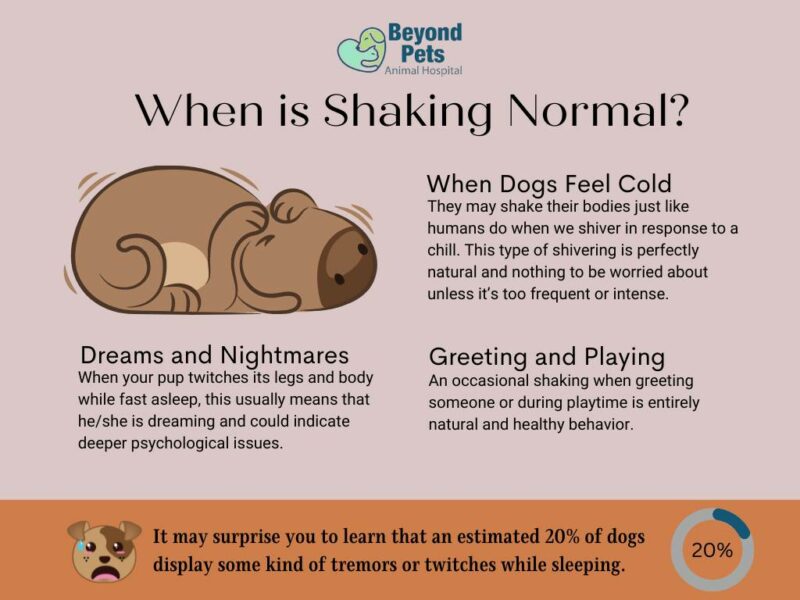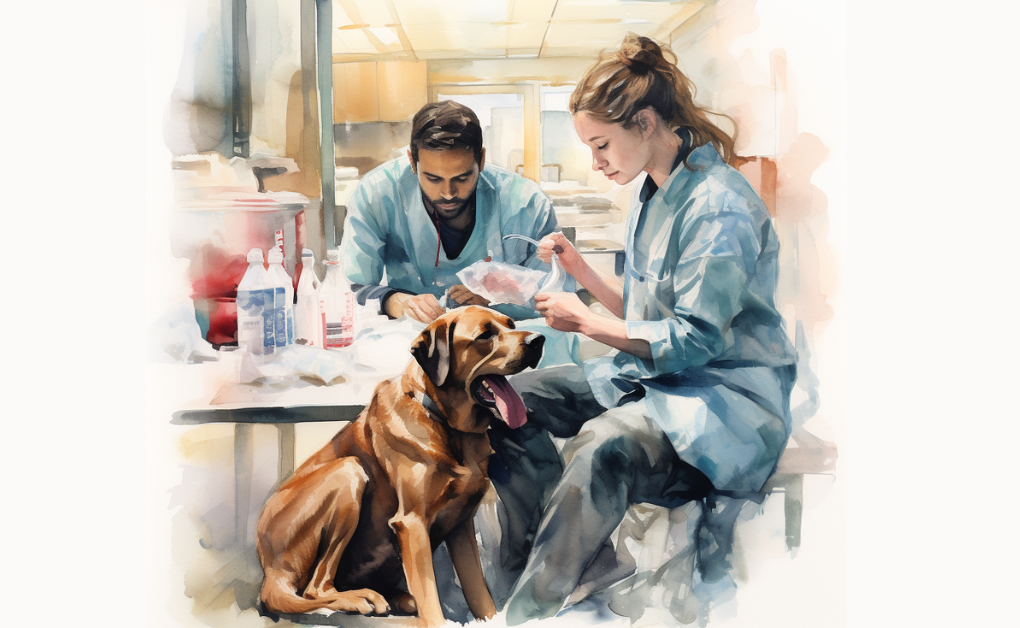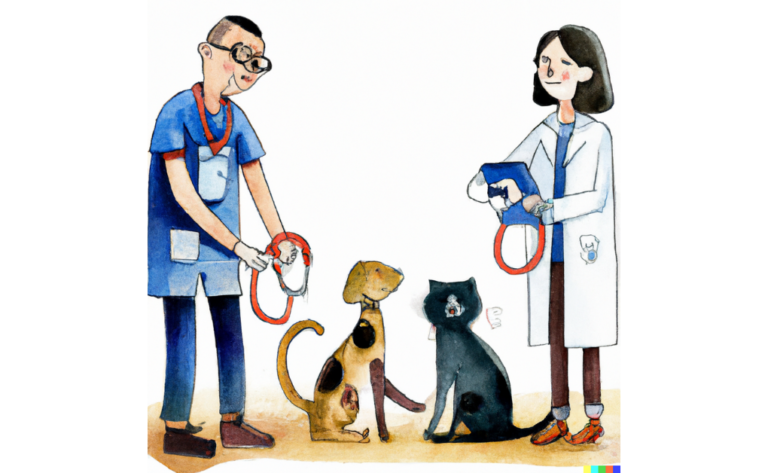Why is My Dog Shaking?
Introduction
Megan had always been a devoted dog mom to her loyal Golden Retriever, Bailey. One evening, while they were snuggled on the couch watching a movie, Megan noticed that Bailey was shaking uncontrollably. Panicked and unsure of what was happening, she immediately called her veterinarian for advice. The vet explained that there could be numerous reasons behind a dog’s shaking, some harmless and others more serious.
When your dog shakes, shivers, or trembles, he’s probably trying to tell you something. He wants you to help him feel safe again. But sometimes, shaking means something else entirely. For example, it might mean that your dog has cancer. Or it might mean that he’s having trouble breathing. In either case, you should get your vet checked out immediately.
If your dog starts shaking, check his ears first. Make sure there aren’t blocked with wax. Then look inside his mouth. Check his teeth and gums for signs of infection. And make sure he doesn’t have any cuts or sores anywhere.
Stress and Anxiety Can Cause Shaking in Dogs

Stress and anxiety can instigate shivering or shaking in dogs, manifesting their emotional and physiological reactions to unsettling situations. Various anxieties afflict 70% of dogs. In addition, analogous to humans, dogs exhibit a fight-or-flight response when confronted with circumstances they perceive as intimidating or stressful, with shaking or trembling being a significant part of this reaction.
Emotional Reaction
Like humans, dogs can endure various emotions, including anxiety and fear. For example, confronted with a stressful situation such as a thunderstorm, fireworks, an unfamiliar environment, or separation from their pet parent, dogs may display anxiety symptoms, including shaking. This reaction is their way of expressing discomfort or distress, and you might notice that your dog may be shaking in response to such triggers.
Physiological Reaction
When a dog is stressed or anxious, their body secretes adrenaline, a hormone that readies its body to react to the perceived threat. This adrenaline surge can trigger physical symptoms like an elevated heart rate, rapid breathing, and trembling, which could appear as a small dog shivering or a large dog shaking noticeably.
Anticipation of Unpleasant Experience
Dogs, particularly fearful dogs, can also associate specific experiences or stimuli with negative results. For instance, if a dog has previously had an adverse experience at a veterinary clinic, such as receiving a vaccine or undergoing a procedure, it may shake in anticipation of discomfort when brought to the clinic again.
Self-Soothing Mechanism
Shaking can also serve as a means for many dogs to alleviate tension or self-soothe during or after a stressful event, especially if the trigger is a loud noise or something that causes fear.
Pet parents must realize that while occasional shaking due to stress or anxiety can be considered regular, constant shaking can indicate that your dog suffers from chronic anxiety or other health issues common in older dogs. Therefore, if you observe that your dog is regularly shaking and displaying other signs of distress, it’s recommended to consult a veterinarian or an emergency vet if needed. They can help determine whether the dog shivering or shaking is due to anxiety, muscle weakness, or a physical health problem and recommend appropriate treatment or management strategies. These are some common reasons dogs get stressed; many may exhibit these symptoms.
Pain Can Be a Reason Why your Dog Shakes
Pain is a significant cause of shaking in dogs. Like humans, dogs may tremble when experiencing discomfort or pain. This could be a result of injury, an underlying medical condition, or after undergoing surgery.
Shaking can serve as a protective mechanism, attempting to soothe the discomfort or as a response to the distress caused by pain. However, it can also signify that your dog is trying to cope with discomfort or emotional distress. For instance, a dog with joint pain due to arthritis might shake, particularly after physical activity.
If your dog is persistently shaking or showing other signs of pain like whimpering, limping, or changes in behavior or appetite, it’s critical to consult a vet. They can identify the cause of the pain and recommend appropriate treatment.
Ear Problems Make Dogs Shiver
Ear complications can indeed induce dogs to shiver or shake. The ear, a vulnerable part of a dog’s body, is easily affected by discomfort, infection, or inflammation, resulting in noticeable reactions such as head shaking, ear scratching, or even full-body trembling.
For instance, ear infections is common in dogs and can cause significant discomfort. These infections can incite inflammation and augment wax production, resulting in itchiness and pain. In response to this discomfort, a dog may frequently shake its head or display signs of dogs trembling.
Furthermore, if a foreign object or parasites, like a tick or a piece of grass, or ear mites get lodged in a dog’s ear, it can incite substantial discomfort leading to shaking. As a pet owner, if you think your dog is persistently shivering, especially when paired with signs of ear discomfort, it’s crucial to call your vet for proper diagnosis and treatment.
Your Dog May Be Poisoned
Dogs can shake or tremble when they have ingested a toxic substance. Poisoning can result in various symptoms in dogs depending on the type of poison, the amount consumed, and the dog’s size, breed, and overall health status.
Shaking or trembling in dogs due to poisoning is often a sign of neurological involvement. Some toxins, such as
- certain types of plants,
- pesticides
- antifreeze
- certain foods (like chocolate, grapes, or xylitol in sugar-free foods),
These can affect the dog’s nervous system, leading to tremors, seizures, or even loss of coordination. Other poisoning symptoms in dogs can include vomiting, diarrhea, drooling, loss of appetite, irregular heartbeat, and changes in behavior like restlessness or lethargy.
If you suspect your dog has ingested a toxic substance, it is crucial to seek veterinary attention immediately. Try to give your vet as much information as possible about what your dog might have ingested and when. Prompt treatment can make a significant difference in the outcome.
Low Blood Sugar Can Cause Trembling in Dogs

Low blood sugar, or hypoglycemia, can indeed lead to trembling or shaking in dogs. The brain is a significant consumer of glucose, using about half of all the sugar energy in the body. Therefore, when blood sugar levels drop significantly, the brain struggles to function correctly, and one of the first signs can be neurological symptoms like trembling.
When a dog’s blood sugar level drops too low, the body can’t deliver adequate energy to the muscles, causing weakness, which could be perceived as shaking or trembling. Other symptoms of low blood sugar in dogs may include disorientation, lethargy, loss of coordination, seizures, and in severe cases, even loss of consciousness or coma.
Certain breeds, like toy breeds, puppies, or dogs with diabetes, are more susceptible to episodes of hypoglycemia. If you notice your dog shaking with any of these symptoms, getting them to a vet is essential as soon as possible. If left untreated, severe hypoglycemia can be life-threatening.
Canine Distemper
Canine distemper is a highly contagious and potentially fatal viral disease affecting dogs and wildlife. This virus affects multiple body systems, including the respiratory, gastrointestinal, and nervous systems.
The shaking or tremors seen in dogs with canine distemper often result from the virus’s impact on the nervous system. Specifically, the virus can cause inflammation and damage the brain and spinal cord (collectively known as the central nervous system or CNS). This damage can lead to various neurological signs, including muscle tremors, twitching, or even seizures.
In the final stages of the disease, dogs may develop “chewing gum fits,” a distinct symptom characterized by rhythmic jaw movements that can look like shivering or shaking. These symptoms are more commonly observed in the late stages of the disease and indicate severe neurological involvement.
Generalized Tremor Syndrome (GTS)
Generalized Tremor Syndrome (GTS), also known as Steroid Responsive Tremor Syndrome or White Shaker Syndrome, is a disorder that causes dogs to experience full-body tremors. While the exact cause is unknown, it’s believed to be an inflammatory condition affecting the central nervous system.
Dogs with GTS suffer from frequent and involuntary muscle movements that can vary in severity, causing them to shake or tremble. These tremors typically involve the entire body, though sometimes they may be more noticeable in certain areas, such as the head or limbs.
The shaking is usually unrelated to any physical activity and can occur whether the dog rests or moves. It’s also not associated with a fever or other signs of illness, although it can cause difficulty with walking and balance if the tremors are severe.
It’s important to note that while the tremors can be alarming, they generally don’t cause pain or discomfort to the dog. The syndrome is named “Steroid Responsive” because it often responds well to treatment with corticosteroids, which reduce inflammation and can help to control tremors.
Underlying Medical Conditions
Dogs shaking can be a symptom of various underlying health conditions. Here are some principal medical concerns that could cause your dog to shake:
- Old Age and Health Deterioration: As dogs grow older, they may develop health issues that result in shaking. These can include general weakness, muscle mass loss, or degenerative myelopathy.
- Canine Cognitive Dysfunction (CCD): Often called doggy dementia, CCD can lead to numerous symptoms, including shaking, due to alterations in the dog’s nervous system as they age.
- Anxiety or Stress Disorders: These mental health conditions can physically manifest in dogs, leading to trembling or muscle twitching symptoms.
- Cold or Hypothermia: Much like humans, cold dogs may shiver. Hypothermia, a dangerously low body temperature, can also induce shivering.
- Excitement or Fear: Intense emotions can trigger shaking in dogs. This could be due to something positive, like anticipating a walk, or negative, like fear during a thunderstorm or fireworks.
- White Shaker Syndrome or White Shaker Dog Syndrome: This condition mainly affects small white dogs, such as the West Highland White Terrier, causing widespread shaking. The exact cause is uncertain, but it’s believed to be linked to the immune system.
- Muscle Weakness or Injury: If a dog has sustained a muscle injury or is experiencing general weakness, it may shake or tremble.
- Certain Medications: Some drugs can cause side effects, including shaking or tremors.
- Cushing’s Disease and Addison’s Disease: These endocrine disorders, caused by an excess or deficiency of certain hormones from the adrenal gland, can result in shaking, among other symptoms.
- Seizure Disorders: These neurological conditions can cause various symptoms, including shaking or trembling.
Dog owners must note that shaking can be a symptom of many different conditions, some of which are serious. In addition, the common reasons your dog could be shaking vary greatly. Therefore, if you observe your dog shaking and are unsure why or if they’re reacting to another dog, it’s always best to take it to the vet to rule out any potentially serious health issues.
Anxious of Frightened
A lot of dogs experience anxiety during veterinary visits. If your dog is anxious, it may shake, tremble, pace, hide under furniture, or even run away. This happens because your dog feels scared, nervous, or uncomfortable. If your dog acts like this, it doesn’t mean he’s sick. He needs some reassurance.
The best way to handle anxious behavior is to help calm your dog down. You can do this by being patient and reassuring. When he starts shaking or trembling, don’t try to touch him. Instead, sit quietly next to him and offer gentle petting. Don’t force him to look at you. Let him come to you.
Normal Shaking in Dogs

What are the Things You Should Do if Your Dog is Shaking?
If your dog is shaking, there are several measures you can take to ensure their health and well-being:
- Assess the situation: Observe your dog’s behavior before becoming overly concerned. Are there any clear reasons why your dog may be trembling? Could they be cold, excited, or fearful? If the shaking is situational and diminishes once the stimulus is removed, it might not be a cause for concern.
- Monitor for additional symptoms: Look for other signs of an illness or injury, such as lethargy, appetite loss, behavioral changes, vomiting, diarrhea, or difficulty walking. Shaking may be a sign that your dog is in pain or even that your dog is nauseous.
- Soothe your dog: If your dog appears anxious or scared, provide comfort by stroking them, speaking in a calming voice, or offering a safe, serene space for them to unwind. These actions can help your dog feel more at ease.
- Document the shaking: Record a video of your dog’s shaking or excessive head shaking to present to your vet. This documentation could aid in diagnosing the problem.
- Get in touch with your vet: If the shaking is continuous, unexplained, or accompanied by other worrying symptoms, it’s crucial to contact your vet promptly. They can advise based on your dog’s specific situation and schedule an appointment if necessary.
- Provide warmth: If your dog is shaking due to being cold, ensure they are sufficiently warmed with blankets or a doggy sweater, mainly if your dog is prone to feeling cold.
Remember, it’s always safer to err on the side of caution. If you need clarification on why your dog is shaking or if you suspect it might be trembling due to an unidentified issue, it’s always best to seek professional advice. Dogs can shake for many reasons, which could also be a sign of other problems. Your vet can offer the necessary diagnostics and treatments to ensure your dog’s health and well-being.
When Should You See a Vet?
You should seek veterinary attention for your dog under the following circumstances:
- Persistent shaking or trembling: If your dog’s shaking doesn’t stop after a short period or keeps recurring, getting them checked out is essential.
- Accompanying distress signs: If your dog appears anxious, in pain, or shows other signs of distress, such as excessive panting, drooling, or vocalizing, they should be seen by a vet.
- Other physical symptoms: Any shaking accompanied by other physical symptoms like vomiting, diarrhea, loss of appetite, lethargy, change in behavior, uncoordinated movements, or seizures warrants an immediate vet visit.
- Post-exposure to toxins: If you know or suspect your dog has ingested something poisonous or harmful and they begin to shake, they should be taken to the vet immediately.
- Unexplained behavior changes: If your dog’s shaking is accompanied by a sudden change in behavior or personality, such as aggression, confusion, or withdrawal, this could be a sign of a more serious issue and should be addressed immediately.
- Older dogs: If your dog is older and begins to shake or tremble, this could be a sign of a severe condition like kidney disease or cognitive dysfunction syndrome and should be addressed promptly.
- Sudden onset: Any sudden, unexplained onset of shaking should be investigated by a veterinarian.
Remember, always trust your instincts as a pet owner. If something seems wrong, it’s always better to be safe and consult a professional. Your vet can provide a thorough examination and appropriate treatment to ensure your dog’s health and well-being.
Frequently Asked Questions
Disclaimer: The information provided on this veterinary website is intended for general educational purposes only and should not be considered as a substitute for professional veterinary advice, diagnosis, or treatment. Always consult a licensed veterinarian for any concerns or questions regarding the health and well-being of your pet. This website does not claim to cover every possible situation or provide exhaustive knowledge on the subjects presented. The owners and contributors of this website are not responsible for any harm or loss that may result from the use or misuse of the information provided herein.







